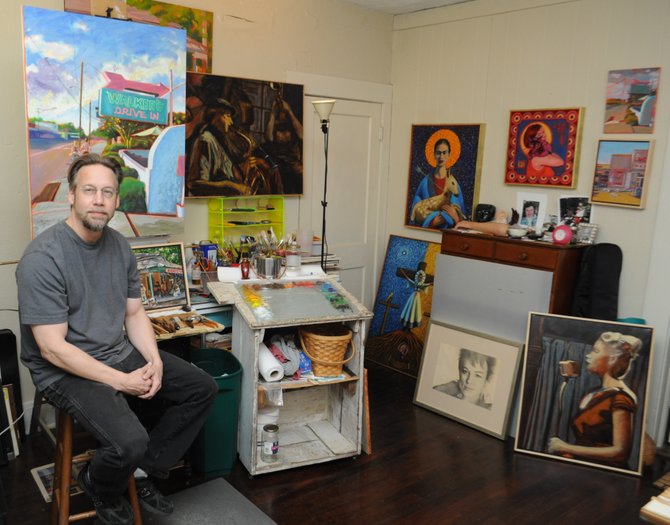Paul Fayard combines his skills as an artist with his background in psychology as a prosthesis artist. Photo by Trip Burns
The first instinct is usually the correct one. Artist Paul Fayard studied psychology and worked as a mental health counselor for "a lot of years" before rediscovering an instinctive affinity for making art.
"They tell me that I would fall asleep drawing as a kid," he says of his childhood in New Orleans. He calls drawing his "first love."
Now he paints and draws in a home studio in Clinton, and works a day job that uses his skills in the fields of both psychology and art. Fayard is an anaplastologist at Alatheia, a prosthesis company named in reference to the Greek goddess of truth.
Fayard creates strikingly realistic prosthetics--anything from entire hands to eyeballs--for clients with injuries or diseases that resulted in the removal or stunted growth of a part of the body.
"No matter what king of weird thing you can imagine, it happens all the time--you just don't see it," says Fayard, who draws on his experience in "therapeutic communication" to work with the clients.
"I really appreciate all those years in psych ... I really enjoy the clinical aspect, meaning the time I get to actually spend with the client. I take the impressions, talk to the people," Fayard says. "It's a safe place for them."
Inevitably, the fortitude and gratefulness of the clients enhance Fayard's own daily living. This gratefulness, like the Buddhist idea of mindfulness, keeps Fayard's artistic mind at work, he says..
"You've got to do it every day, because if you don't do it every day, you start to get apprehensive about it," Fayard says. "That's the only way to keep continuity. When I stop on a painting, I always stop at a good point, and I know what I'm going to do when I come back."
In fitting prosthetics, Fayard creates ways of minimizing the transition between the silicone prosthetic and the client's real skin. But in painting, he says, Richard Diebenkorn's work inspires him because "he's making sure you know that it's plastic" with a technical usage of the paint that allows the viewer to "see into the process."
In a painting that depicts a pair of runners on North State Street in front of Walker's Drive-In, Fayard balances the coolness of the scene with subtle and bare bright orange strokes that add a dose of the magical to the light blue clouds, the shrubs and even the sewer drain.
"With my art, I'm trying to focus the attention and say, look, the ordinary is really the extraordinary," Fayard says.
He got the inspiration for this painting one day while walking and taking photos in Fondren with his girlfriend.
"This couple came running down the street, and it was a beautiful day, and I thought, that's a happening--that's a scene right there," he says. "I was able to use them as models in the reference--just kind of the human element. That's going back to psychology, which is why I think I was drawn to that in the first place."
He laughs about a recent conversation with Wyatt Waters about the painting.
"I told him, 'Ron (Lindsay) told me I've been hanging around you too long and my titles are getting just as cheesy as yours,'" Fayard says. The piece is called "Walkers and Runners," a pun combining the restaurant's name with the runners blazing past.
Looking around his home studio, Fayard says, "A lot of these scenes are inspired by Frenchman Street, and then what's not is inspired by Fondren. I kind of have my two muses--I have my Jackson muse and my New Orleans muse."
While the sense of the two places makes his work catchy for southerners, it is that "human element" that drives his work.
"The more you look," Fayard says, "the more you see."


